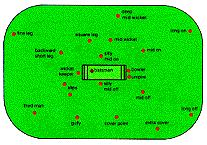

12 April 2001
[Introduction]
Cricket is a bat-and-ball game played between two teams consisting of 11 players on each side. The game is played on a grassy field about 150m X 70m in size. A boundary is marked to set the limits of the playing area. The size of a field is not the same everywhere. The center of the field consists of two wickets, 20m apart, each with 3 stumps placed close together so that the ball does not pass through them.

There are two umpires in a match. One stands behind the bowler's wicket, and the other about 15 yards away, at the square leg position, from the batsman. The objective of this game is similar to baseball, only the rules are different. The bowler has to throw the ball and hit the wicket with the ball. The batsman has to protect the wicket, hit the ball with his bat and score runs.
One player from the other team, a batsman, stands at each wicket. One faces the bowler and the other stands at the other wicket from which the bowler throws (bowls) the ball. When the batsman hits the ball, he may run to the other wicket where his partner is standing and his partner may run to the other wicket from which the ball was hit -- this is one complete run. The batsmen run for a run when they think they can reach their opposite ends without getting run out.

The batsmen can run up to only four times back and forth between the wickets and score 4 runs. Other ways of scoring faster is to hit the ball hard enough to cross the boundary for 4 or 6 runs. A batsman can get out if he is bowled, caught, stumped, lbw, or runout. After each over the bowling ends are changed and the fielding is also reversed. When a batsman is out another batsman from the same team comes to play. A team has a limit of playing all their 11 players, but a batsman always has to have a partner at the other end. Therefore, after 10 players are out the eleventh player does not have a partner and the innings is officially over. Then the other team bats and tries to chase the target set by its opponent.
[Team Tactics]
The captain should not only know how and when to manipulate his fielders, the fielders themselves must realise the job expected of them in their particular positions.
To view the diagrams (full size), click on following links : -
[Captaincy]
What makes a good captain?
1. Leadership qualities.
A captain must have the ability to lead his side by performance and thereby gain the respect of his players. He must not shirk any of the 'dirty' duties.
2. Man-management skills.
He must know what makes each member of his team tick so that he can motivate them to perform to the best of their ability.
3. Sound tactical skills.
He must know when to attack and when to defend. He must have complete control of field placins and be able to ascertain batsmen's weanesses and exploit them.
4. Knowledge of the laws and competitions.
Often a certain law or a change in competition of rules can have a profound effect on the game. the captain must be completely clued-up so that he can make the correct decisions.
5. Discipline.
There are times when a captain has to crack the whip if a player argues with an umpire. He must ensure that the game is conducted in the right spirit.
6. Compassion.
Occassionally players fail and have to be dropped. The captain myst be able to handle these and other problems with diplomacy.
7. Ruthlessness.
When he has a side on the run, he must 'go for the jugular', and not let the opposition off the hook.
8. Administrative capabilites.
A captain has certain roles, depending on the club. He must make sure that he :
a) puts up the team sheet on the notice-board
b) ensures that tea and lunch are organised
c) arranges the travelling for away games
d) on match days : assesses the wicket; tosses with the opposing captain; decides on whether to bat or bowl; posts the batting order; motivates the team; tells them what his initial ideas are and who is going to open the bowling.
Captaincy is a heavy respobsibility and not for the faint-hearted.
Any comments ? Email us at cricketplanet@yahoo.com.sg
© 2001 Cricketplanet.com.sg